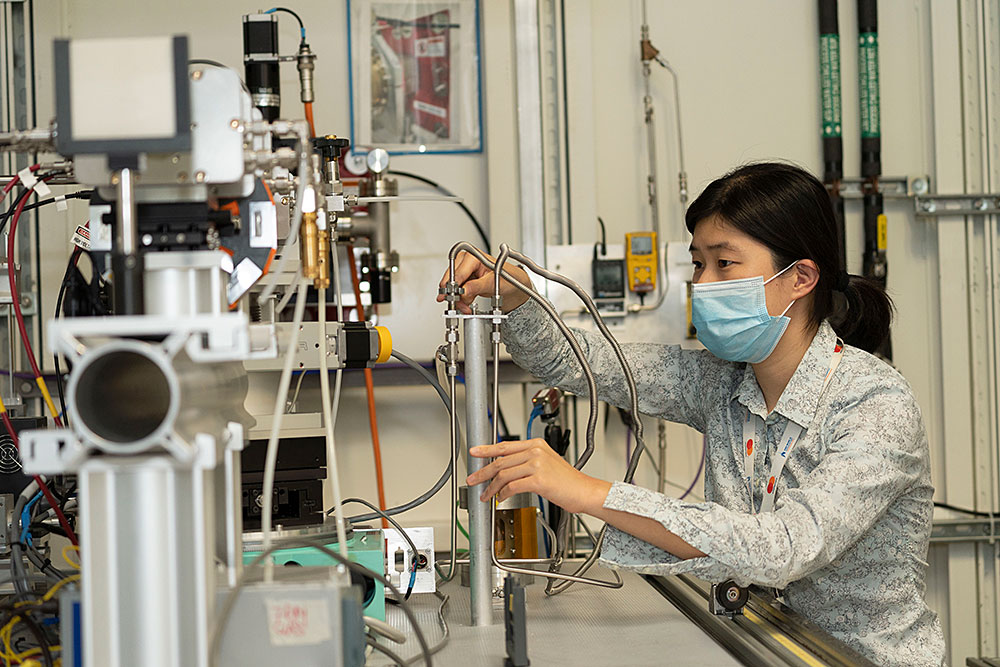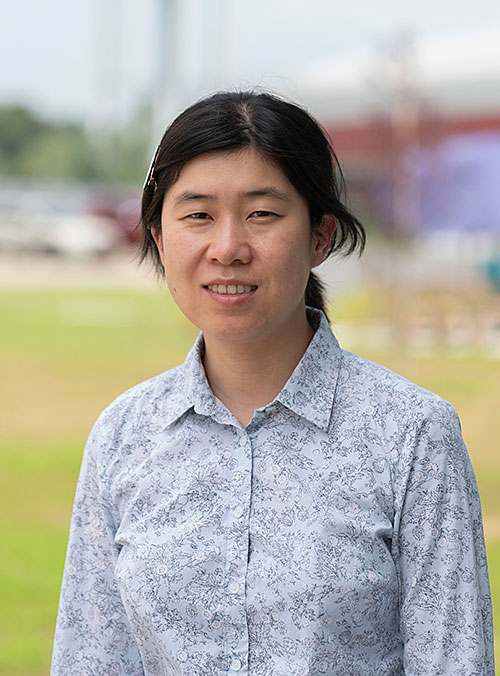Meet Lu Ma, Scientist at the NSLS-II Quick X-Ray Absorption & Scattering Beamline
Ma leads the operation and development of the QAS beamline and helped create the QAS remote user program
August 29, 2022
Lu Ma is a beamline scientist working within the Hard X-Ray Scattering & Spectroscopy program at National Synchrotron Light Source II (NSLS-II), a U.S. Department of Energy (DOE) Office of Science User Facility located at DOE’s Brookhaven National Laboratory. NSLS-II produces ultra-bright beams of x-rays that are used to study a wide variety of samples, from potential new battery materials to cell proteins.
What do you do at NSLS-II?
I am a beamline scientist in the Hard X-ray Scattering & Spectroscopy group, where I work at the Quick x-ray Absorption and Scattering (QAS) beamline. I came to NSLS-II about three years ago, only six months before the start of the pandemic. My job, essentially, is to support user experiments and expand the beamline’s capabilities, especially its multi-modal characterization capabilities.
When I arrived, one of my first projects was helping to build a remote-user program. The remote-user program allows users to remotely join experiments, which are operated by local beamline staff. In order for this to work efficiently, we need to communicate extensively with the users to understand the details of their experiments and update the beamline capabilities accordingly. After reaching an agreement, the experiments usually proceed as planned. But, occasionally, some extra measurements are needed with unexpected and usually exciting new findings.
What are some of the challenges you have faced?
QAS is a multi-modal beamline with both spectroscopy and diffraction capabilities, which means that the users can explore their samples using different techniques. One issue we ran into was that the detector for diffraction was not designed for combined spectroscopy and diffraction measurements, which makes it difficult to use, especially remotely. I submitted a facility improvement proposal for a new detector. It was funded by NSLS-II. The new detector will expand the type of measurements that are possible at QAS, such as measuring x-ray diffraction and spectroscopy sequentially without extra steps for tuning the energy or moving the detector. It will enable true fast switching between spectroscopy and diffraction, thus improving the efficiency of remote operations at QAS. It is still under development but we hope it will be ready for users by the end of the year.
Another challenge for me is how to balance between user support and my own research. My research interests focus on using in situ x-ray absorption spectroscopy and diffraction to study materials for lithium-ion (Li-ion) batteries – and beyond – and heterogenous catalysis, a type of catalysis that can yield reaction products on a larger and faster scale than other approaches. QAS is a high-throughput beamline, which means we have a lot of users coming for experiments. So it’s hard to find the right balance between my research time and user support; I am still learning how to improve that while also maintaining a healthy work/life balance. One method I learned from my mentor is to record my daily work and summarize it every week to have a better picture of the time I spend on different tasks.
What is a typical workday like for you?
After I arrive at work, I usually jump into an introduction of the beamline for the current users and give them the necessary beamline training. For remote users, this might involve a virtual tour of the beamline or going over how the beamline works. After that we will briefly go through the experimental plan. Then, I will optimize the beamline optics for their experiment, set up the instrumentation, and explain the process of taking measurements. I often meet with them afterward to talk about their progress, as there are always unexpected discoveries uncovered during the scientific exploration.
During the time that users are working by themselves, I have other work to do, including scheduling, proposal reviews, coordination of the beamline development project, and also my own research and professional development.
How did you come to be an NSLS-II employee?
During my graduate studies in the Department of Chemistry and Biochemistry at Ohio State University, I was given the opportunity to do the last two years of my graduate work at beamline 9-BM at the Advanced Photon Source (APS) at Argonne National Laboratory. After graduation, I took a postdoc position at APS for another two years until I joined QAS. QAS uses similar spectroscopic techniques as the beamline I worked on at APS, which was also an x-ray absorption beamline, but QAS has many multi-modal characterization opportunities.
What do you enjoy most about your work?
I like that I get to talk to users with all different backgrounds. We learn a lot from each other: They inspire me by discussing recent updates in their fields and I provide assistance with experimental design, beamline operation, and data analysis. These collaborative efforts combine our knowledge and benefit both parties, ultimately making the experiment better.
I’ve especially learned a lot about batteries and catalysis, which are hot topics often studied at QAS. I have been working in these fields and hope to pursue these interests. This work also offers so many great opportunities to learn and find ways for expanding the beamline’s capabilities in battery and catalysis studies.
What do you like to do outside of work?
I enjoy hiking and playing video games. Tetris is my favorite, especially Tetris99, where I can play against 98 other players.
Before the pandemic, I would travel several times a year. In the pandemic, I haven’t been able to travel to do any hiking, so I have been doing it locally. I like that I can go to the beach here.
How does your work support the mission of NSLS-II?
QAS accommodates many users working in the fields of energy and catalysis. They are working to find ways to produce cleaner energy. This is directly in line with the mission of NSLS-II: to deliver high-impact, cutting-edge science and technology for the benefit of society. I’m proud of our role in supporting and enriching users’ research and yielding productive scientific publications. Meanwhile, I’m developing the multi-modal aspect of QAS to make the beamline more efficient and the experimental results more reliable. So, in these ways, I am supporting NSLS-II’s mission by making the user experience better, leading to better research results.
Brookhaven National Laboratory is supported by the Office of Science of the U.S. Department of Energy. The Office of Science is the single largest supporter of basic research in the physical sciences in the United States and is working to address some of the most pressing challenges of our time. For more information, please visit science.energy.gov
Follow @BrookhavenLab on Twitter or find us on Facebook.
2022-20777 | INT/EXT | Newsroom











